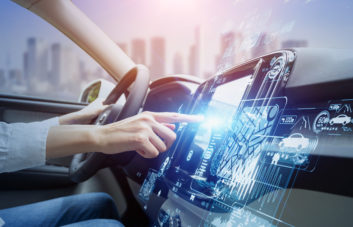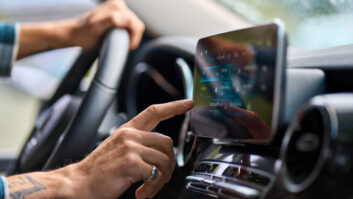
Automakers have long included traditional AM/FM radios in new vehicles at no charge, with broadcasters gladly nodding their approval.
But Fred Jacobs says the relationship between those parties is changing as automakers look to monetize the dashboard further.
Jacobs, founder of consulting firm Jacobs Media, wrote in a series of recent blog posts about how radio has fit into the dash historically and who will dictate its path to the future. He even contemplates a world where in-dash entertainment systems in new vehicles are no longer considered a standard feature.
Rethinking radio
Car manufacturers are making vital decisions right now about how entertainment will be consumed in the connected car in the ever-expanding Apple and Google in-car ecosystems. New in-vehicle dashboards with internet-based auto infotainment systems could potentially contain a new revenue stream for automakers, Jacobs says.
Many radio industry leaders believe it’s crucial that broadcasters engage with metadata service providers and automakers to keep over-the-air radio in the front of this dashboard discussion.
Analog and HD Radio, hybrid radio, dash visuals and in-vehicle voice interaction are part of the in-car focus of radio broadcasters in the United States. But the acceptance of the Android Automotive vehicle operating system by multiple automotive manufacturers, including Ford, GM, VW, Group PSA and Volvo, is a critical development when considering how automakers view the connected car.
ABI Research recently said it expects 36 million vehicles will be shipped with Android Automotive in 2030.
Jacobs says this is the perfect time for the radio industry to dig deep for the answers to many questions about its future.
“So, the idea that some automakers are rethinking their 90-year policy of radios solidly positioned in the center of their dashboards — now known as head units — should send shockwaves throughout the radio business from Napa to New York,” Jacobs wrote in the fall.
He argues that it would be a mistake to assume that traditional AM/FM radio will always be in the dash and offered as a free feature to car buyers. He said broadcasters who are oblivious to recent developments are putting future success at great risk.
“For nine decades, automakers have graciously included radios (first AM, then FM, now HD) as standard equipment on most of their vehicles — while not charging radio broadcasters a dime. Like any smart business, they are now looking for ways to monetize their dashboards, from payments from content creators (e.g. SiriusXM) to the data they have.”
Jacobs wrote: “Because it has always been considered standard equipment — like the glove box, rear-view mirror and turn indicators — inertia has kept automakers dutifully installing those car radios in dashboards.
“Take a moment and consider it from Ford, Toyota, Subaru or Volvo’s point of view. The only party generating revenue from those car radios in the dash are radio broadcasters. Radio stations and networks have been successfully monetizing them for nearly a century.”
And don’t think installing car radios and infotainment systems like Apple CarPlay or Android Auto doesn’t cost the automakers money, Jacobs said.
“Despite what you’ve heard, installing radios in cars doesn’t just cost automakers a buck or two. There are engineering, equipment, installation, quality control and other associated costs. And given the scale of being an auto manufacturer, you take your savings wherever you can find them.”
Watching Tesla
Jacobs likens it to “automakers doing radio broadcasters a big favor” over the years.

But recent dashboard evolution — including moves by Elon Musk’s Tesla, which Jacobs says is at the center of the movement to remove radio from the automakers electric vehicles — makes hybrid entertainment solutions a primary focus in which radio can be harder to locate.
Smart infotainment systems, which consider listener preferences in their displays, could ultimately push radio further down the list of entertainment options, he said.
Tesla for instance has a $1,500 upgrade package for older-model Teslas, Jacobs wrote, which does away with broadcast radio and satellite reception. And to get radio reception capability reinstalled on a Tesla will cost the owner another $500, Jacobs added incredulously. Nonetheless, he thinks the rest of the auto industry is watching Teslas’s moves closely.
“The other auto companies are begrudgingly taking notice. And they are slowly but surely incorporating Musk’s operating philosophies in their own companies.”
Loss of momentum
Radio broadcasters historically have struggled in their dealings with automakers, Jacobs told Radio World, because the broadcast industry is not monolithic.
“Like the audio industry’s 30-something OEMs, auto companies also are independent operators, each of whom has their own priorities and strategies,” he said. “It’s like herding cats.”
Jacobs acknowledged efforts by the National Association of Broadcasters in recent years to build ties with the OEM sector. But, he wrote: “As we know, the NAB has had a particularly challenging couple of years, between a new building, leadership changes, conference cancellations and other speed bumps.”
The most recent in-car developments coincide with what Jacobs perceives is a potential “loss of momentum” by the radio broadcast industry and their efforts to build relationships with the auto industry.
“Every company and organization has been rocked by the shifting media landscape, and of course, COVID. The disruption has been unprecedented, forcing most players to focus inward, rather than addressing existential challenges — like the car dashboard.
“Unfortunately, the automakers and their T1 partners have not been in neutral. They are in rapid development mode, trying to stay cutting-edge in dashboard technology. And they have challenges of their own, including the question of integrating expanded services from Apple and Google.”
Jacobs compared the recent situation to “a slow leak” directly tied to consumer acquisition of new (and later model) vehicles with more options and capabilities.
“The one-two punch of pairing a smartphone and being able to access satellite radio challenges broadcasters’ abilities to hold their own. Our research clearly shows driving a true connected car with a system like Ford SYNC or Chrysler UConnect has a direct impact on AM/FM radio’s ability to hold onto its consumption level in cars,” Jacobs said.
Google Automotive Services is locking down OEMs, Jacobs said, with a deep integration of its features, controlling everything from climate to the windshield wipers to, of course, the media system via voice.
And Android and Apple systems, which are being placed in cars with advanced voice command systems, seemingly make the radio tuner harder to find in new dashboard technology.
Jacobs told Radio World: “It is an imperative broadcast radio stays front and center on those auto display screens. Properly enabled radio station mobile apps appear on both CarPlay and Android Auto. And metadata support and dash display is more important than ever.”
Hybrid radio in connected cars will present radio broadcasters opportunities to “attract an audience outside of a station’s signal range,” Jacobs says.
Jacobs complimented Xperi Corp, licensee of HD Radio and developer of the hybrid radio DTS AutoStage platform, for its efforts making inroads in the world of automotive.
“They are connected with virtually every OEM in the world, connected to more than 10,000 radio stations.” He said the company has long had a presence in Detroit, which “is where auto business gets done.”
Xperi believes the DTS AutoStage system will help radio stations address many of the concerns Jacobs mentioned, including visibility in the dash, but that would rely on carmakers adopting it widely.
Jacobs included a call to action in his last blog in the series. He identified ways in which radio broadcasters could establish better presence in the auto community. The ideas range from a grassroots effort for radio stations to engage their local car dealers to utilizing big stars like Ryan Seacrest and Bobby Bones to promote the medium on a national level.
He also is vocal about the importance of managing the way your station appears to the listener.
“Radio stations have a tremendous amount of control over what appears on the screens of millions of cars and trucks. Problem is, they rarely do anything about it. If there was ever a radio content category that programmers, sellers and managers simply left in the ‘set it and forget it’ category, it’s in-dash messaging, better known as metadata.”
Regardless, Jacobs says radio broadcasters must work to solidify relationships with the auto industry: “It will require radio broadcasting’s leadership to set aside their differences and speak in one voice.”
“The car dashboard is a mini billboard”
Quu recently commissioned Jacobs Media to gather feedback about metadata messaging and displays from American drivers. Jacobs interviewed 19 drivers about their reactions to a variety of simulated “radio stations” displaying metadata messages. Key findings:
- Artist and title information is table stakes. “Consumers expect it from the audio platforms they listen to, whether it’s satellite radio, audio streaming services, or broadcast radio.”
- Album art could be a powerful feature for radio broadcasters. “Most respondents find it to be a welcome addition to the dashboard experience.”
- Ads that include relevant text and logos tend to have higher unaided recall. “Metadata should be brief, compact, and match the commercial’s audio message. Similar to billboard copy, text for ads should include the fewest words possible.”
- Continuous text ads displayed on top of other audio ads in a commercial break are confusing to most respondents. “Additionally, recall tends to be poorer for these ads, as well as for the commercials they cover.”
- Jacobs concluded that radio broadcasters need to improve the dashboard experience by adopting metadata standards to improve continuity and clarity of messaging on car display screens. “Oftentimes, radio does not compare well to other services, like satellite radio or audio streaming services.”
In short, listeners like visual content that matches what they are hearing on-air. Conversely, they get confused or even annoyed when visual messaging is unrelated to what they are hearing.
Read more at https://myquu.net/news/, and scroll to “Jacobs Study on Ad Metadata.”







